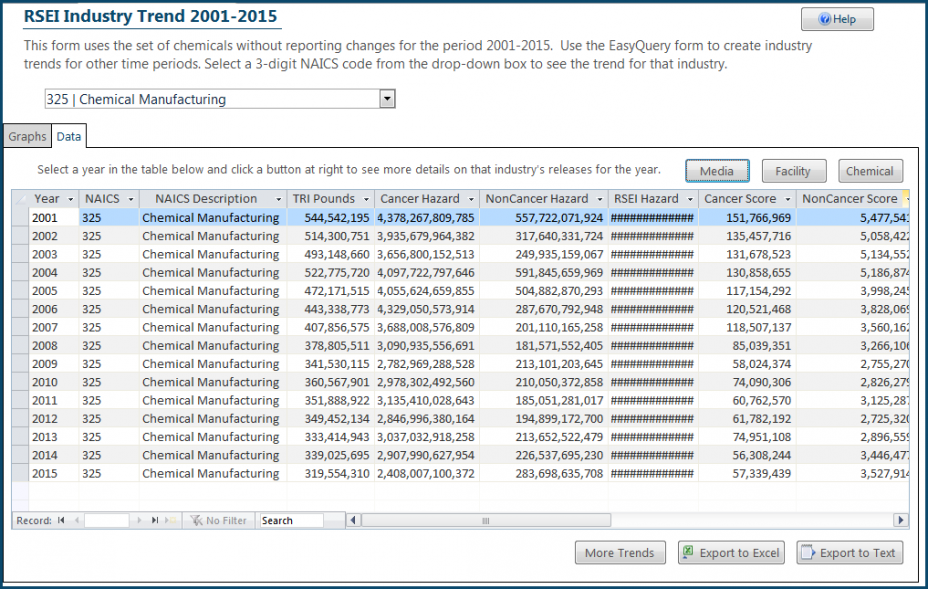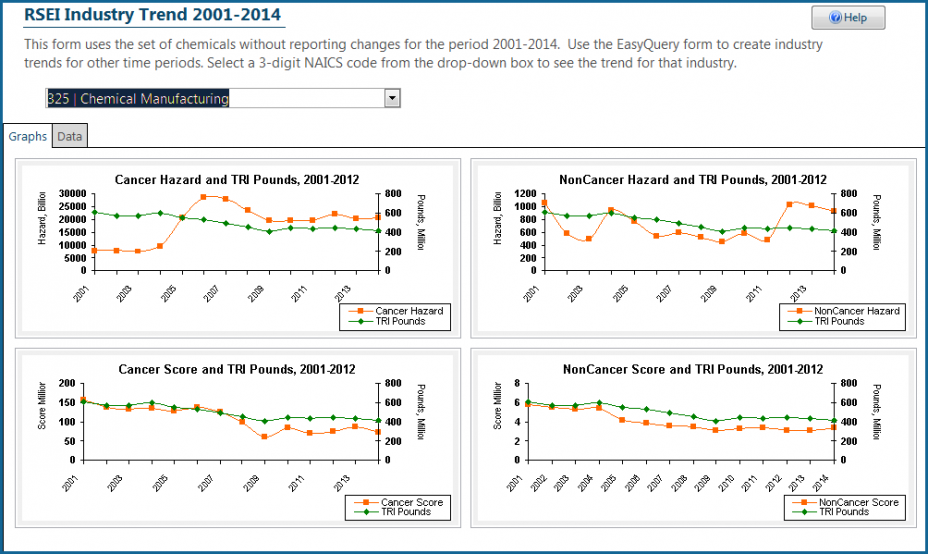EasyRSEI Online Help - Trends
EasyRSEI trends show how impacts from releases from the Toxics Release Inventory (TRI) have changed over time. Each trend shows the annual totals for TRI-reported pounds and the six results produced by EPA's Risk-Screening Environmental Indicators (RSEI) model (RSEI Score, RSEI Hazard, etc.). Learn about RSEI.
The following trends are available from the main RSEI form:
- National Trend: Results by year for 2001-current year. Additional tabs show more detailed results by chemical, media, facility and industry for a selected year.
- Chemical Trend: Results by chemical for 2001-current year.
- Industry Trend: Results by 3-digit NAICS code for 2001-current year.
- State Trend: Results by State for 2001-current year.
- EPA Region Trend: Results by EPA region for 2001-current year.
Each trend form contains a Graphs tab with the trend for Cancer Score, NonCancer Score, Cancer Hazard, and NonCancer Hazard and a Data tab that contains the data included in the graphs, plus RSEI Score and RSEI Hazard. More help on understanding RSEI results.
Trends are limited to the set of chemicals whose reporting requirements have not changed over the time period covered. The trends listed above contain all but a small number of currently-reported TRI chemicals. The following additional national trends cover longer periods of time but include a smaller set of chemicals. They are available by clicking the “More Trends” button on the Data tab of each 2001 trend. These additional trends do not have the additional tabs included on the National Trend for 2001-current.
- National Trend: 1988-current. Includes only those chemicals with unchanged reporting requirements over the whole reporting period. Note that this trend excludes all of the chemicals in the 1995 expansion.
- National Trend: 1995-current. Includes all of the chemicals in the 1995 expansion.
- National Trend: 1998-current. Includes only those chemicals with unchanged reporting requirements 1998-current.
- National Trend: 2000-current. Includes only those chemicals with unchanged reporting requirements 2000-current. The set of chemicals is the same as that used for the 2001-current trend, except that “lead and lead compounds” is not included in the 2000-current trend.
- National Trend: 2001-current (redirects to the National Trend described above).
EasyRSEI trends forms have graphs and data tables, as shown below. Click on the tabs at the top to switch between the graph and the data table.

EasyRSEI data tables have Microsoft Access functionality. You can click on the arrow to the right of any column header to sort by the column header. You can also use the options at the bottom of the table to filter the table results or search for a text string or number.
You can export the data shown on the screen by using the "Export" buttons.
Trend data tables also have drill down buttons, as shown above at the top right. Select a row in the table and then click one of the buttons for more information. For example, in the table above, the user has selected 2001 and NAICS code 325 in the table. Clicking on the "Media" button would open a new form with a series of graphs showing the media breakdown of all releases from facilities with a primary NAICS code of 325 in 2001- that is, what percentage went to stack air, what percentage went to direct water, etc., by different results (TRI Pounds, Cancer Hazard, NonCancer Hazard, Cancer Score, NonCancer Score).
For some drill down buttons, or drop-down menu selections, the refresh of the graphs and tables, or the opening of the new form may take a few seconds. This will depend on your computer. Look at the bottom right of your screen for a status bar. Click and hold the escape key to cancel the request.

